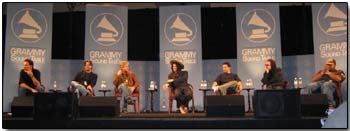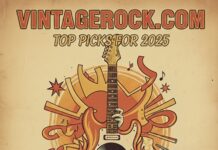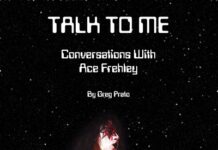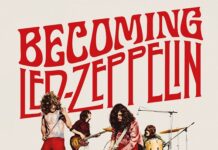By Shawn Perry
Here I am, once again, bouncing back and forth from aisle to aisle in the thick of one of the music industry’s quirkiest events – the NAMM show. Like a head-on collision, this is something I can’t seem to avoid. It just so happens that every January, for the past 30 odd years, the National Association of Music Merchants (NAMM) has staged its infamous winter show in Southern California, for the most part at the Anaheim Convention Center, across the street from Disneyland. For me, a life-long SoCal resident, it’s certainly convenient for me that NAMM takes place in my own backyard. As an outsider, I’ve watched what was once a simple showcase of musical instruments and products grow into a hi-tech, lurid behemoth popping at the seams and literally stopping traffic. Just parking your car can be a raging nightmare. But once you get inside, it’s easy to get caught up in the hubbub.

Many of the self-appointed pop culturists of the day are claiming the music industry, as we know it, is teetering on the brink of extinction. But the 75,000 or so that swarmed to this year’s NAMM show still have a deep, almost obsessive need for the tools of the trade. There are more gadgets and gizmos to pick, kick, pluck, suck, blow, beat, hit, strum, scratch, and pound than you can shake a concert mallet at. Every square inch of the Anaheim Convention Center, its capacity supposedly expanded to accommodate NAMM, is swooning with gear, accessories and every kind of knick-knack imaginable.
Squeezed in between all the hardware and software are lots of people. Mind you these are not your typical, garden-variety conventioneers looking to mix a little business with pleasure before heading home to attend to their domestic others. Well, there are probably a few of those too, but you’d never know by the looks of some of them. You can always tell who the musicians are because most of them look like they’re ready to walk on stage at the drop of a whammy bar. Big hair, no hair, purple hair, green hair, and latex n’ leather are virtual mainstays, especially near the watering holes that dot the NAMM landscape, stretching beyond the confines of the convention center over into the Hilton and Marriott Hotels. Elsewhere, the suits compete for the coveted prize of signing a suitably attired musician type to endorse their products. It’s a win-win situation as far as that goes.

Amidst the freeloaders and caregivers is a scourge of individuals who really have no business whatsoever for being at the NAMM show. They just want to soak up the environment, perhaps catch a glimpse of their favorite guitar player walking amongst the regular folk. I’m not that much different from them. I’ve been coming to the Winter NAMM show for almost 20 years on various missions — as a buyer, an exhibitor, a roadie, a networker, a journalist and even a gawker. And while the spectacle and immensity can be daunting in its vexation, this convention remains one of the last get- togethers of its kind where musically minded maniacs can assemble and make a little noise without getting busted, slaughtered, denigrated or spat on in the process. Its appeal is understandable and not without merit.
On the Showroom Floor
I’m strolling across the showroom floor, trying to find an angle. What sets this show apart from the others that came before? I must admit I never paid that close attention to the finite details of NAMM, and this time is no exception. There are a few random modifications you can’t help but notice. Many have been subtly developed over the years. Music software now comprises a hefty portion of the exhibit hall. A regular software alley is a-buzzing with high energy demos, free CDs, T–shirts and Earth, Wind and Fire. Elsewhere, the turntable, for years an essential consumer item for “listening” to music, is being marketed as an “instrument” of sorts for DJs, who demonstrate their wares alongside “traditional” musicians. Sure didn’t see that one coming.
Down in the basement of the convention center are some of the more entangled exhibitors who warily attach themselves to the music biz. Dozens of dot-comers, including E-bay, are muscling in on the action by offering various online services for the musician. Elsewhere, it’s always nice to see the wood routers out in force, just to remind everyone there’s a lot more to making a guitar than meets the eye. But the one who stole the show for me had to be the Snakemann, a self-styled, wild-eyed tattooed entrepreneur who told me he was making a profit with his own customized jewelry line. Nowadays, you gotta have the bling bling if you want make it in this business.
As for the big boys, the blue chip exhibitors, there were few standouts. Gibson and Fender were somewhat nonchalant on the second floor along with the dozens of rooms occupied by the ominous piano manufacturers nobody seems to visit (maybe they only have to sell one). I’d hate to move those suckers up and out of there.

Thankfully, Ernie Ball is one company who knows how to throw a party. In the last few years, they’ve come up with some clever and amusing themes to build their exhibits around. Last year, their sales reps were dressed like football players, pitching their wares on a makeshift gridiron. This year, they sailed in on the high seas as pirates, a boatload of swashbuckling reps maneuvering the replicated ship to accommodate visitors. Who knows what they have in store for next year.
One Ernie Ball “guest” making the rounds is guitarist Steve Lukather, not dressed as a pirate. “Ernie Ball is like my family,” he tells me. Hey, a seat on the captain’s bridge and free coffee and donuts — what more could you ask for? Steve then counts off his activities of late. “I’ve been touring with Toto for three years and I have a new Christmas album available on stevelukather.net.” He spells it out for me. And, with the obligatory plug delivered, his work is done. Actually, the guy couldn’t have been nicer. Truly a class act amongst the numerous freaks and geeks wandering the NAMM topography.
Over at the Zildjian cymbal booth, there’s a line-up of drummers signing autographs. Of the dozen or so, I recognize three and decide to see what they have to say. The first one is an old acquaintance I have vaguely known since his days with Black Sabbath in the mid 80s. Eric Singer has to be one of the most seasoned musicians I’ve ever met. After Sabbath, he co-found Badlands, a short-lived, underrated hard rockin’ foursome from the late 80s that featured former Ozzy Osbourne guitarist Jake E. Lee and vocalist Ray Gillan, a Sabbath alumnus who passed away in 1993 from AIDS-related complications. For much of the 90s, Singer pounded the skins for KISS and is presently touring with Alice Cooper (although I just heard he’s back in KISS). With such a demanding schedule, he still makes it to NAMM every January. So, I ask him, what makes this year different from any other year?
“This year’s NAMM? It’s about the same as 2003 and 2002 and 2001 and probably 94 and 84,” he laughs, adding, “it keeps growing every year, so maybe that’s it.”
Alan White, a personal favorite of mine who’s been with Yes for over 30 years, and spent considerable studio and stage time with John Lennon and George Harrison in the early 70s, was a little more candid. “I’ve only been here for a couple hours and I’ve been working since I got in, so I haven’t really seen anything. But I’ll be here all weekend.” I comment on his speedboat featured in the latest Yes DVD, YESSPEAKS and he chuckles lightly at the thought. I could tell he was missing that boat.

Then it’s over to Clem Burke, the Blondie drummer famous for his Keith Moon-like attack, who assumes a more serious tone. “I think for an artist, it’s more of social thing. It’s great to meet some of the guys from the music companies.”
Producers SoundTable
One of the most intriguing aspects of NAMM is the sideshow seminars and conferences that take place in many of the neighboring hotels. Of those, perhaps none is more fascinating than the panel of A-list music producers put on display for the Grammy® Producers SoundTable. Now in its 11th year, the event is a somber step away from the showroom floor where producers get down and dirty and talk about how they work, whom they’ve worked with, and why they work the way they work. Having attended a previous SoundTable with the likes of Quincy Jones and Roy Thomas Baker regaling the crowd with stories of Michael Jackson and Queen, I am expecting a stellar presentation from this year’s lineup.
As it turns out, there are indeed some heavy hitters on this year’s dais. With David Adelson, VP of Hits magazine, moderating, there’s Michael Bienhorn, a lively and outspoken veteran who broke out in 1984 with Herbie Hancock’s “Rockit” and has gone on to produce records for Ozzy Osbourne, Aerosmith and Marilyn Manson. He looks perfectly normal. So does the subservient Patrick Leonard, who’s made a slew of records with Madonna, as well as Pink Floyd and his own short-lived band, Toy Matinee. Next to him is Steve Lillywhite, a well-spoken Englishman famous for producing the first three U2 albums before going into the studio with the Pogues, Rolling Stones and Phish.
I’m surprised to see Jonathan Davis, the lead singer of alt-metal sensations Korn, sitting amongst this elite set of knob twisters. Apparently, he has an impressive producer’s resume that extends beyond his own band. Another fresh face is that of Damon Elliot, an incalculable presence with production credits that include Destiny’s Child and Pink. But the one who takes the cake has to be the man sitting in the very middle, sporting a straw hat, dreadlocks and no shoes or socks: Don Was. Of all the panelists, Was, a true eccentric who has turned the dials for the Stones and Bob Dylan, really knows how to put a presentation on its ear.
Commenting on producing an artist like Keith Richards, he recounts: “The first time I met him, he said, ‘I don’t need a producer.’ But I got the gig…” He laughs at the relationship he has since developed with the Stones. “You just don’t enforce an agenda. You learn to roll with it.”

After each producer has his say, a short clip of his work is played. While each is distinctive in its own way, none is more galvanizing than Leonard’s demo of Roger Waters’ new song. The room goes dead silent as Waters sings each lyric, something about Michelangelo, with heartfelt resonance. It’s the best vocal I’ve ever heard from the guy. Leonard tells a story about how he received the lyrics in the mail and a friend of his, who happened to be a songwriter, asked to read them. After he was done, he shed a tear.
From there, the focus of the SoundTable shifts abruptly onto a sticky and controversial topic: the digital revolution. Unexpectedly, both Was and Bienhorn are remarkably forthright about the whole downloading issue. “The whole premise of the music business is stealing artists’ music,” Was muses. “I don’t care – I download.”
Bienhorn adds, “The music industry is a mess. But if you have a creative vision, it’s a great time.”
Lillywhite is inclined to disagree. “Bootlegging is an incredible problem.”
Davis follows suit. “To me, downloading is stealing.”
Having the last word, Was lays his cards out on the table. “The collapse of the music industry is due to quality and price ratio.” He appears unworried. “I acknowledge I’m part of the problem. I’ve made mediocre records that I’ve charged too much for…”
After touching on some technological innovations that leave the producers salivating, a short Q&A follows and I beat a hasty retreat. It’s time for another round on the showroom floor. I want to look over some guitars, bump into old friends, maybe even take a few pictures for prosperity.
Guitars and Girls
The guitar and girls angle is afoul like a bucking bronco from the likes of Jackson, Charvel, Ibanez, ESP, and B.C.Rich. But the classic designs from Gibson, Fender, Paul Reed Smith, Rickenbacker, et al. still reign supreme. So much so that others have followed in their wake with some surprising results.

As I’m dashing through the basement, I notice one booth in particular, with posters of a guitar concealing the private parts of an extremely beautiful woman. It’s a surefire ploy. Guitars and girls are a natural fit no matter how you look at it. The company is called RKS guitars and seated behind a table in the middle of their booth has to be one of the most gorgeous women I have ever seen – the girl on the poster! She’s signing copies for the asking. I come to find out her name is Petra Verkaik, a Playboy Playmate who continues to appear in the magazine on a semi-regular basis. And she’s tucked away in the basement of NAMM! I ask her when she gets off, she laughs and I laugh back, not quite sure what the joke is. No matter, she signs a poster for me and throws me a kiss. I’m in heaven.
The other interesting thing about RKS guitars is its affiliation with a notable figure, not quite as staggeringly stunning as the poster girl, but a legend in many music circles. I’m speaking of the one and only Dave Mason. As it turns out, Mason has a big stake in RKS and is lending his reputation to help solidify the deal. So, instead of asking him about his days with Traffic, his recording sessions with Hendrix, or his long- standing solo career, I ask him about these new guitars.
He tells me that he and co-founder, Ravi Sawhney, who was runs RKS as an industrial design company, started “goofing around” with guitars on the side. “We worked on it,” Mason says. “It became a project.” Three years later, RKS rolls out a line of three guitars and one bass boasting a distinctive modular design they call “open architecture.”
How involved was Mason in the design process?
“I designed the headstock because originally there was no headstock.”
Standing by, Sawhney adds, “When we started there was no headstock, it was a square body with no controls. There was no tone, no balance. Dave saw something we didn’t see. He started coming in day after day. We sketched, we evolved. There were about 15 design models.”
Mason interjects, “We all kind of learned along the way because I’ve never built a guitar.”
So what exactly is open architecture?
Sawhney has a ready-made answer. “Open architecture means the headstock through the body is all made from one solid piece. So it gets a certain tone and resonance. That allows us to manufacture a very high-end, unique, custom guitar.”
I ask Mason if he’s using these guitars. “I used one on a couple of tracks on my new album,” he replies. “And I’ve used one on stage.”

At that moment, I spot legendary guitarist Jeff “Skunk” Baxter checking out one of the new RKS guitars. I ask him what he thinks. “It plays like a dream,” he says.” It’s an incredibly well built and well designed instrument.”
At this point, I feel like I’ve gotten everything I need, so I head upstairs. As I sweep by the tower of amps at Ibanez, through the cave of Paul Reed Smith and into the main arena, which is converted into a menagerie of lights and special effects, I have but one thought on my mind: beer.
The Hilton
The after-show parties that take place in and around the Hilton Hotel, just steps away from the convention center, would make…well…Paris Hilton blush. After a couple of Heinekens and small five dollar pizza from Pizza Hut in the Marriott’s snack bar, I amble on over to the Hilton. While searching for friends, associates and acquaintances, I catch a show in one of the hotel’s three bars where guitarist Frank Gambale and ex-Journey drummer Steve Smith are kicking out the jams. Collectively, they’re called Vital Information, and they bring the house down. Later that evening, I congratulate Smith on a job well done. He congratulates me on beating Smashing Pumpkins drummer Jimmy Chamberlain in a game of pool. And with that, I’m outta there, off to new adventures.
Over the years, NAMM has been known for staging some incredible jam sessions. I recall seeing Eddie Van Halen, John Entwistle, Sammy Hagar, Slash, Albert Lee, Steve Morse and dozens of others gather together on a stage in one of the ballrooms and play for hours. Recently, the gigs have become a little more organized, played at offsite venues, like the House of Blues at Disneyland and Sun Theater (now The Grove of Anaheim) over in the parking lot of Edison Field, and even opened to the public. Last year’s NAMM-sponsored, all-star tribute to Elton John took the cake as it was held at the Arrowhead Pond, an 18,000 seater. With Brain Wilson, Randy Newman, Michael McDonald, Jewel, Norah Jones and even Ray Charles, it was a phenomenal event. Even so, the spontaneity of the old ballroom jams was missing. This year, there is an odd assortment of percussionists and other specialized styles in the ballrooms. Carlos Santana was slated to head up a heavy lineup at the Galaxy Theatre, 10 miles or so from the convention center. But Santana called in sick and interest waned, although I didn’t personally go. Even so, I opt for a cozy steak dinner with 20 others including Creed’s Mark Tremonti at the local Outback.
Later, I’m back at the Hilton, drinking greyhounds with Glen Tipton from Judas Priest in a side booth next to one of the hotel’s bars. I soon realize the guy never finishes his drink. One slurp and he’s off, cruising the corridors for desirable rock babes. He returns to our table three or four times, asking for another drink despite the fact that all his unfinished drinks sit there, waiting to be dusted off. I tell him I just reviewed a new Judas Priest DVD that features highlights of the band during the 70s and 80s. He tells me that he and compatriot KK. Downing and reinstated vocalist Rob Halford are writing new material for the new Judas Priest album down in Coronado, near San Diego. And from what I hear, they’ll be touring with the Ozzfest festival this summer. Even though I’m not that much of a headbanger, this reunion definitely has potential.
And so it goes until you’re sick of drinking and making small-talk with the makers of music, the makers of musical instruments, and everyone else strictly on the make. The social aspect of NAMM is something a lot of people don’t like to talk about, actually. Who knows, maybe they just forget. But it’s all part of the spectacle and glamour that comes with the music business. Anyone who says they’re not in the music business for the money and sex and parties and all the other loony attachments is lying through their teeth. NAMM just keeps the whole affair that much more respectable.





















